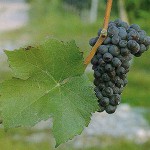
Il Nebbiolo
A native grape of Piedmont, it has its best output in the Barolo wine, where it occupies its best exposures, the richest aromatic complexity and the best balance between acidity and tannins, which give it a great longevity. The grapes mature very late, with harvest in the second half of October. The wine has a faded color, which takes on garnet and orange undertones.

Il Barbera
It is the most widespread Piedmontese black berry vine, accounting for about half of the regional production. The vine is rural, with a good adaptability and a high natural acidity even when fully mature which makes it fit also for the warmer seasons. The relative poverty in tannins is balanced by the fragrance of the perfumes, and the strength of the wine makes it suitable for refining in oak casks, which softens its acid profile.

Il Dolcetto
Early Piedmontese grapes, with low acidity, which mature in mid September; this fact makes it possible its cultivation also in exposed and elevated areas such as the high Langa and high Monferrato regions. Dolcetto is the daily Piedmontese wine, soft, fruity and tannic. The vinification is difficult, a true test for an winemaker, who has to cope with very short harvesting periods, intense pigments, low acidity and strong tannins.

Il Cabernet Sauvignon
This vine is native of the Bordeaux region; its adaptability has made it the prototype of the international vine. It gives to the wine fruity, vegetable fragrances, tannins and color. The ripe grape has bluish tones, a thick skin and stands well also humid or rainy climates. The incomplete ripening, however, tends to “mark” too much and to make the final product under-refined.

Il Pinot Nero
This vine is native of Burgundy region, very delicate, exacting both in the vineyard and in the cellar, is at its best only if cultivated with extreme care in suitable, not too warm, grounds. Faded in color and poor in tannins, the wine needs a long ripening in order to express its best refinement and charm.